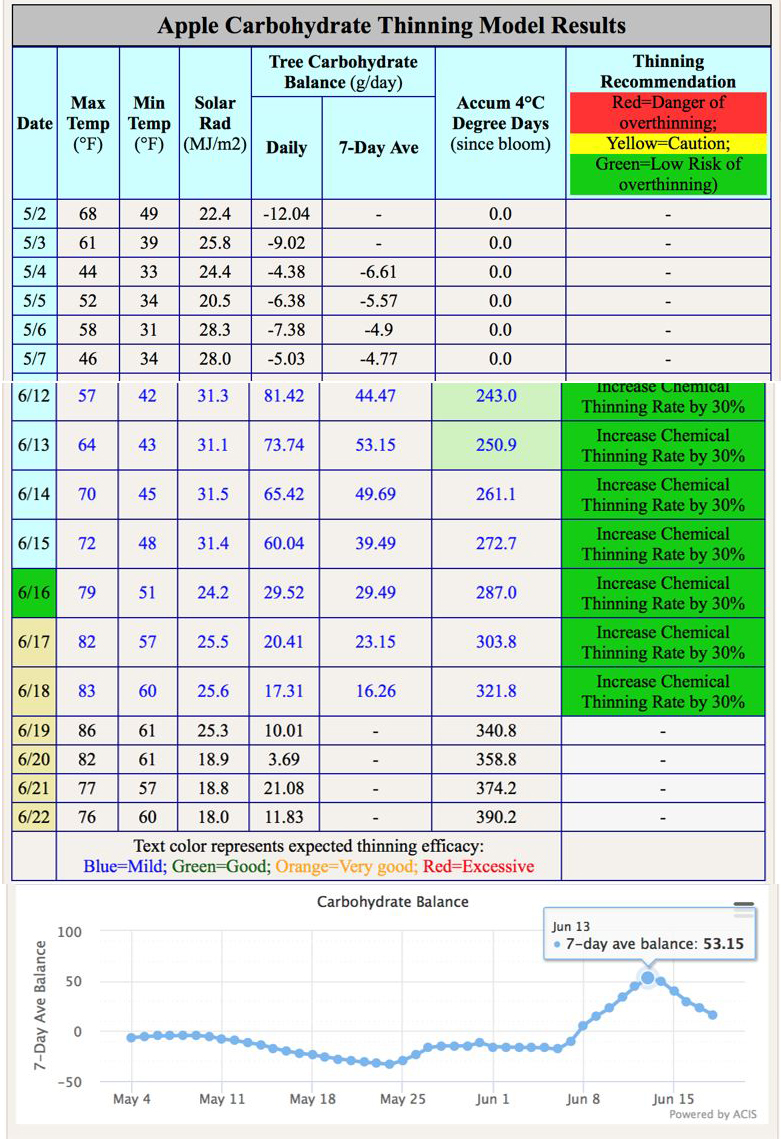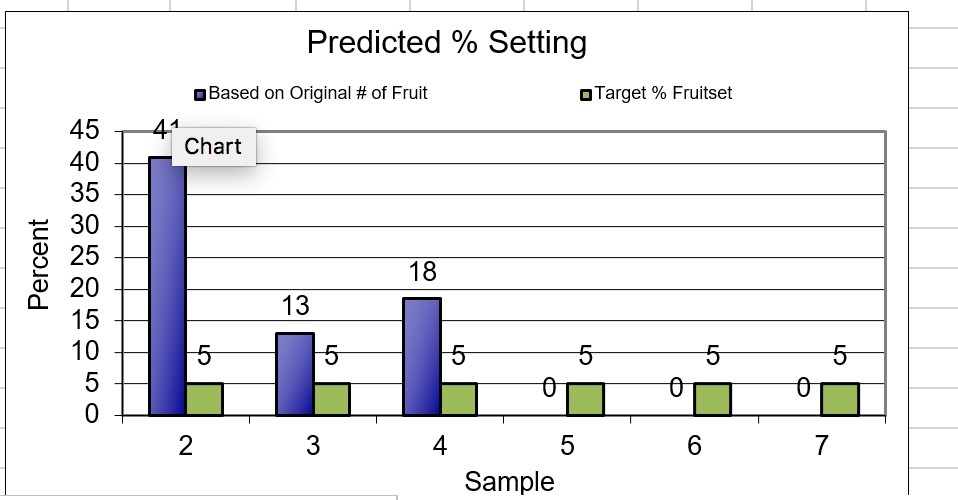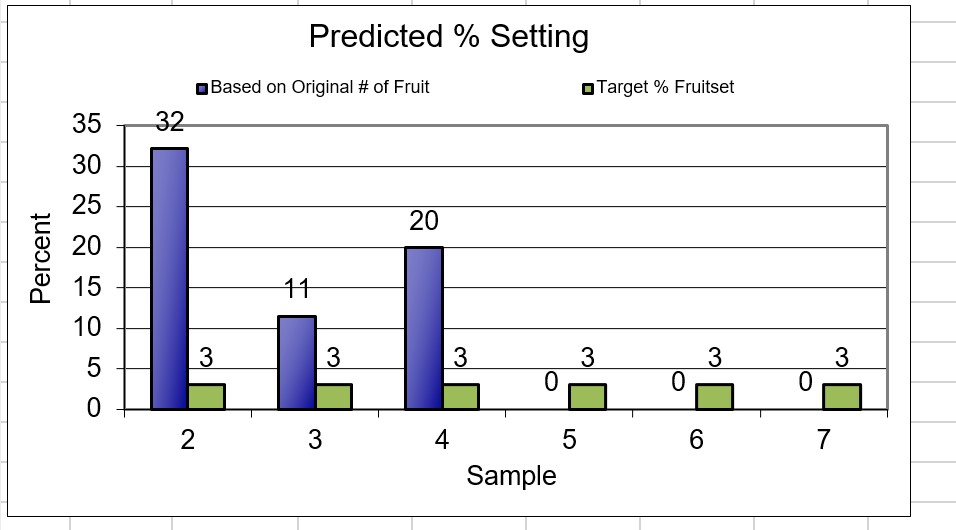Northwest Michigan fruit update – June 16, 2020
Fruit continues to size adequately. Growers are concentrating on thinning apples at this critical time.

Weather report
The weather has been seasonably warm over the past week, albeit a bit cool over the weekend. Daytime temperatures were only into the high 50s F on Friday, June 12, but got progressively warmer through the weekend. Despite the sunny days that eventually warmed, nighttime temperatures have been cool—good sleeping weather! Nighttime temperatures have been in the low to mid-40s for the past week, and the warm weather comes on slowly into the day.
We are still accumulating growing degree days (GDD) faster than the start of the season, but we are behind our 25-plus-year averages. We have accumulated 796 GDD base 42 and 440 GDD base 50. The GDD averages for the Northwest Michigan Horticulture Research Center are 938 GDD base 42 and 519.7 GDD base 50.
Michigan State University agricultural meteorologist Jeff Andresen says the forecast is calling for warmer than normal temperatures, including nighttime temperatures. The weather has been dry since the last rainfall on June 10 and 11 where we had 1.31 inches of rain on Wednesday and another 0.11 inches on Thursday at the Northwest Michigan Horticulture Research Center. There is no rain in the forecast until the weekend; the highest chance of rain is on Sunday, June 21, with some potential thunderstorms.
|
Growing degree days (GDDs) through June 15, 2020 | |||||||
|---|---|---|---|---|---|---|---|
|
Year |
2020 |
2019 |
2018 |
2017 |
2016 |
2015 |
30 Yr. Avg. |
|
GDD42 |
796 |
692 |
966 |
990 |
961 |
843 |
938.4 |
|
GDD50 |
440 |
332 |
578 |
542 |
526 |
516 |
519.7 |
View Andresen’s agricultural weather report below.
Crop report
Fruit continues to size across the board. Sweet cherries have increased in size by an average of 2 millimeters for all varieties. Tart cherries have also grown 1-2 millimeters. Apples made bigger jumps. Gala increased in size from 6 to 11 millimeters and Honeycrisp increased from 6 to 10 millimeters.
Crop size is variable for tart cherries across the region where some blocks have a relatively good crop to other growers that are reporting a fairly light crop. We have a few hypotheses as to why the crop seems to be on the light side. First, we had hot temperatures during tart cherry bloom, and bloom lasted only three days at most. Although honey bee hive strength appeared to be good, the span of bloom was so short that perhaps there simply was not enough time to pollinate the fruit. Many growers report they have tiny cherries that never really came out of the shuck. These fruits are significantly smaller than the cherries that were pollinated on the tree, and we think these fruits will likely fall from the tree if they have not already.
Another hypothesis about the lighter crop in tart cherry is the length of the cold period this spring. Lastly, the two really cold nights in May likely also reduced the crop size in cherry, both sweet and tart.
The sweet cherry crop also appears to be lighter than anticipated. Last week, most growers agreed that the sweet cherry crop was good. However, we have heard many reports of fruit drop over the weekend and the crop has thinned down in that time. Balaton crop in most blocks looks good.
Strawberries are started to ripen. The season will likely begin in full next week. Some Earliglow strawberries are starting to color.
Apples are still in a good thinning window. As mentioned above, Gala and Honeycrisp are at 10-11 millimeters, which is in the optimal thinning window. Recent data from Cornell University has found a better gauge for thinning is between 200-250 GDD base 4 degree Celsius from bloom. At the Northwest Michigan Horticulture Research Center, we are at 287 GDD today, June 16, which is past that optimal window.
Prioritize thinning in apples if they are not at their optimal crop load target. The carbohydrate model is predicting no carbohydrate deficit, which will make apples more difficult to thin and increasing the thinner rate may be warranted (Figure 1). Additionally, as fruit are larger in size, they become more difficult to thin; apples in the 18-20 millimeter stage are harder to thin than smaller fruit.

We have been conducting precision orchard management measurements on Gala and Honeycrisp at the station. As mentioned last week, we have noticed quite a spread of sizes of fruitlets within a cluster and within a tree. Additionally, we have noticed quite a drop of fruitlets last week, and there are concerns of overthinning with this drop of fruitlets. We hypothesize that the hot weather and freeze events in may likely impacted the fruitlet strength.
Figure 2 shows the percent of fruit that are setting in Gala. We took our first measurement last Monday, June 8, and we were at 41% fruit set based on our original number of fruits, and our target fruitset percentage is 3%. We measured yesterday (June 15), and we actually had a higher percent fruitset compared with our Friday (June 12) measurements. These numbers are unusual as the percent fruitset typically goes down and gets closer to the target percentage fruitset. This small increase in percentage could be the result of some of the smaller fruitlets increasing in size although many of them look as if they will still drop over time.

We saw similar results in Honeycrisp where the percent fruitset increased from Friday to Mondays measurements (Figure 3).

These results are puzzling and make thinning decisions more difficult. Additionally, we have heard reports of fruit drop across the state, even with no thinner applications. On our fruit call, we have heard of some cases where the check trees are dropping just as many fruitlets as trees that were treated with thinners. Be cautious of overthinning trees this season.
Pest report
Both Enviroweather and RIMpro models are showing that primary apple scab is ongoing. RIMpro is predicting that primary could end after the coming period of wet weather at the end of this week. However, continue to check the models after the wet weather ahead. Spores are at 100% maturity (biofix April 26-27), and according to Enviroweather, 92% have discharged at this time. We have had reports of scab lesions in larger, older trees in commercial blocks, but overall incidence of scab in the region is low.
Apples continue to look free of fire blight. We received a report last week of fire blight symptoms and ooze in pears. The risk of fire blight infections during bloom were high this year and generally few reports of fire blight showing up so far in the area suggest that growers were able to effectively manage this disease during challenging bloom time conditions. Continue to monitor for symptoms following possible trauma blight following last week’s windy conditions.
Untreated trees in the cherry leaf spot efficacy trial have very high infections (Photo 1), and infections that occurred earlier this season are apparent on bract leaves as well as the oldest leaves on terminal ends. Growers are continuing to use a preventative, protectant strategy to prevent the spread of conidia, and we have been fortunate to have a good stretch of weather to get covered before the next rains predicted for the end of the week and into the weekend.
Codling moth catches are consistent with last week with numbers in the single digits above the five moths per trap treatment threshold (for blocks without mating disruption). Since biofix (June 1 ), we have accumulated about 200 GDD base 50. Egg hatch is estimated at 250 GDD base 50 after biofix, and we will be at is the timing at the end of this week on Thursday-Friday. The 250 GDD base 50 post biofix is the traditional timing for managing codling moth larvae.
Two spotted spider mite numbers are increasing on cherries, and European red mites have also been detected in sweet cherries. The numbers of mites in cherries at the station are not above threshold at this time, but warm and dry conditions have been favorable, particularly for two spotted spider mites. European red mite activity is ongoing in apples. All life stages are present in the crops where they were detected.
Potato leafhoppers and white apple leafhoppers are still active; we have not found immature leafhoppers at this time.
We are still finding active obliquebanded leafroller larvae at the station. We have not caught moths in traps.
San Jose scale flight is ongoing, and trap numbers are declining. Crawlers have not been detected at this time. The crawlers can be difficult to detect. One monitoring strategy is to use black electrical tape wrapped sticky side up around branches. The tape should be observed within a day or two after setting it out to be able to see the crawlers clearly. It is also helpful to monitor trees or hot spots with known scale infestation to increase the chance of finding crawlers.
New damage from plum curculio appears to be declining indicating that we are past peak activity of this pest. However, conditions were also cool for a few days following rainy weather last week which would have slowed this pest. We could see a flush of activity in warmer nights this week.
Rose chafers have arrived in the region, and we have found the beetles feeding and skeletonizing leaves. Young trees are particularly vulnerable to the beetles as they can quickly defoliate the few leaves on new trees. We remind growers that the beetles have an aggregation pheromone that attract the beetles to each other; hence, the beetles tend to congregate in hot spot areas. Orchards adjacent to hay fields tend to get pressure from rose chafers after they are cut. Additionally, rose chafer management can be difficult because the beetles can re-infest an orchard quickly after a spray has knocked the population down.
American plum borer numbers declined in traps this week indicating that flight is winding down. Lesser peach tree borer activity increased and we are approaching the degree day timing for peak flight. Traps for greater peach tree borer should go up this week.
Spotted wing drosophila (SWD) traps in Leelanau were checked this morning, and our preliminary data indicate that SWD activity is on the rise. We will continue to check Antrim, Grand Traverse and Benzie traps today and tomorrow, and we will report trap catches as soon as the data are ready. According to the SWD model, there is “low” risk of SWD infestation in tart and sweet cherries at the Northwest Michigan Horticulture Research Center at this time as we are below the GDD mark that indicates that fruit are susceptible to SWD oviposition (Tables 1 and 2).
Please note that even though fruit are not susceptible to SWD oviposition currently, the model suggests that there is low risk rather than no risk because SWD have been detected in the area. The risk for infestation will increase as fruit ripen and GDD reach and exceed 954 GDD base 39.2 F post full bloom.
|
Table 1. Updated SWD Model, June 15, 2020. Risk shown assuming flies are trapped. | ||||
|---|---|---|---|---|
|
Site |
Crop |
Bloom |
GDD 39.2 F as of June 15 |
GDD 39.2 F as of June 21 |
|
SWMREC |
Sweet cherry |
May 1, 2020 |
1010 |
1193 |
|
SWMREC |
Tart cherry |
May 12, 2020 |
917 |
1100 |
|
SE Michigan |
Sweet cherry |
May 4, 2020 |
875 |
1068 |
|
SE Michigan |
Tart cherry |
May 10, 2020 |
839 |
1032 |
|
Sparta |
Sweet cherry |
May 7, 2020 |
836 |
1033 |
|
NWMHRC |
Sweet cherry |
May 22, 2020 |
587 |
775 |
|
NWMHRC |
Tart cherry |
May 26, 2020 |
482 |
670 |
|
Table 2. Updated SWD Model, June 15, 2020. Risk shown assuming no flies are trapped | ||||
|---|---|---|---|---|
|
Site |
Crop |
Bloom |
GDD 39.2 F as of June 15 |
GDD 39.2 F as of June 21 |
|
SWMREC |
Sweet cherry |
May 1, 2020 |
1010 |
1193 |
|
SWMREC |
Tart cherry |
May 12, 2020 |
917 |
1100 |
|
SE Michigan |
Sweet cherry |
May 4, 2020 |
875 |
1068 |
|
SE Michigan |
Tart cherry |
May 10, 2020 |
839 |
1032 |
|
Sparta |
Sweet cherry |
May 7, 2020 |
836 |
1033 |
|
NWMHRC |
Sweet cherry |
May 22, 2020 |
587 |
775 |
|
NWMHRC |
Tart cherry |
May 26, 2020 |
482 |
670 |
|
Traps (0=flies not present, 1=flies present) |
GDD 39.2 F from full bloom |
SWD risk |
|---|---|---|
|
0 |
954>GDD |
none |
|
0 |
954<GDD<1170 |
none |
|
0 |
GDD>1170 |
low |
|
1 |
954>GDD |
low |
|
1 |
954<GDD<1170 |
medium |
|
1 |
GDD>1170 |
high |



 Print
Print Email
Email
